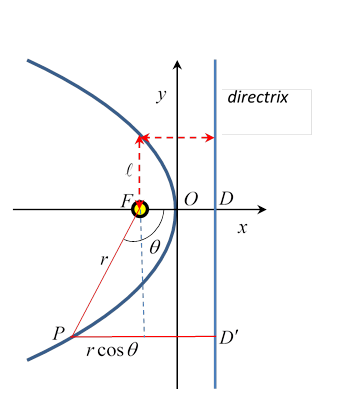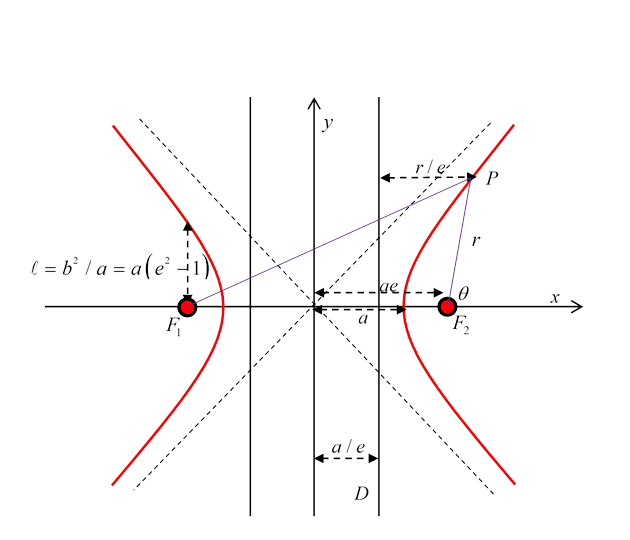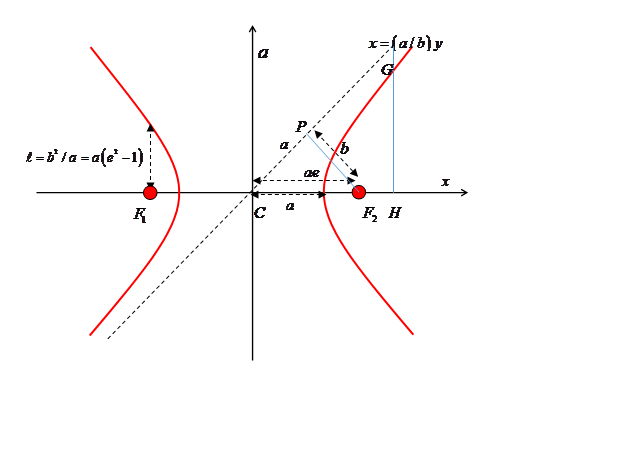Mathematics for Orbits: Ellipses, Parabolas, Hyperbolas
Michael Fowler
Preliminaries: Conic Sections

Ellipses, parabolas and hyperbolas can all be generated by cutting a cone with a plane (see diagrams, from Wikimedia Commons). Taking the cone to be  and substituting the and substituting the  in that equation from the planar equation in that equation from the planar equation where where is the vector perpendicular to the plane from the origin to the plane, gives a quadratic equation in is the vector perpendicular to the plane from the origin to the plane, gives a quadratic equation in  This translates into a quadratic equation in the plane -- take the line of intersection of the cutting plane with the This translates into a quadratic equation in the plane -- take the line of intersection of the cutting plane with the  plane as the plane as the  axis in both, then one is related to the other by a scaling axis in both, then one is related to the other by a scaling  To identify the conic, diagonalized the form, and look at the coefficients of To identify the conic, diagonalized the form, and look at the coefficients of  If they are the same sign, it is an ellipse, opposite, a hyperbola. The parabola is the exceptional case where one is zero, the other equates to a linear term. If they are the same sign, it is an ellipse, opposite, a hyperbola. The parabola is the exceptional case where one is zero, the other equates to a linear term.
It is instructive to see how an important property of the ellipse follows immediately from this construction

. The slanting plane in the figure cuts the cone in an ellipse. Two spheres inside the cone, having circles of contact with the cone  , are adjusted in size so that they both just touch the plane, at points , are adjusted in size so that they both just touch the plane, at points respectively. respectively.
It is easy to see that such spheres exist, for example start with a tiny sphere inside the cone near the point, and gradually inflate it, keeping it spherical and touching the cone, until it touches the plane. Now consider a point on the ellipse. Draw two lines: one from on the ellipse. Draw two lines: one from to the point to the point where the small sphere touches, the other up the cone, aiming for the vertex, but stopping at the point of intersection with the circle where the small sphere touches, the other up the cone, aiming for the vertex, but stopping at the point of intersection with the circle Both these lines are tangents to the small sphere, and so have the same length. (The tangents to a sphere from a point outside it form a cone, they are all of equal length.) Now repeat with Both these lines are tangents to the small sphere, and so have the same length. (The tangents to a sphere from a point outside it form a cone, they are all of equal length.) Now repeat with We find that We find that  the distances to the circles measured along the line through the vertex. So the distances to the circles measured along the line through the vertex. So  in the obvious notation -- in the obvious notation --  are therefore evidently the foci of the ellipse. are therefore evidently the foci of the ellipse.
The Ellipse
Squashed Circles and Gardeners
The simplest nontrivial planetary orbit is a circle:  is centered at the origin and has radius is centered at the origin and has radius An ellipse is a circle scaled (squashed) in one direction, so an ellipse centered at the origin with semimajor axis An ellipse is a circle scaled (squashed) in one direction, so an ellipse centered at the origin with semimajor axis and semiminor axis and semiminor axis has equation has equation

in the standard notation, a circle of radius scaled by a factor scaled by a factor  in the in the direction. (It's usual to orient the larger axis along direction. (It's usual to orient the larger axis along ) )
A circle can also be defined as the set of points which are the same distance from a given point, and an ellipse can be defined as the set of points such that the sum of the distances from two fixed points is a constant length(which must obviously be greater than the distance between the two points!). This is sometimes called the gardener's definition: to set the outline of an elliptic flower bed in a lawn, a gardener would drive in two stakes, tie a loose string between them, then pull the string tight in all different directions to form the outline. from a given point, and an ellipse can be defined as the set of points such that the sum of the distances from two fixed points is a constant length(which must obviously be greater than the distance between the two points!). This is sometimes called the gardener's definition: to set the outline of an elliptic flower bed in a lawn, a gardener would drive in two stakes, tie a loose string between them, then pull the string tight in all different directions to form the outline.

In the diagram, the stakes are at  , the red lines are the string, , the red lines are the string,  is an arbitrary point on the ellipse. is an arbitrary point on the ellipse.
 is called the semimajor axis length is called the semimajor axis length  , , the semiminor axis, length the semiminor axis, length  . .
 are called the foci (plural of focus). are called the foci (plural of focus).
Notice first that the string has to be of length  , because it must stretch along the major axis from , because it must stretch along the major axis from  to to  then back to then back to  , and for that configuration there's a double length of string along , and for that configuration there's a double length of string along  and a single length from and a single length from  to to  . But the length . But the length  is the same as is the same as  , so the total length of string is the same as the total length , so the total length of string is the same as the total length 
Suppose now we put  at at . Since . Since  and the string has length and the string has length , the length , the length 

We get a useful result by applying Pythagoras' theorem to the triangle 

(We shall use this shortly.)
Evidently, for a circle, 
Eccentricity
The eccentricity of the ellipse is defined by of the ellipse is defined by

Eccentric just means off center, this is how far the focus is off the center of the ellipse, as a fraction of the semimajor axis. The eccentricity of a circle is zero. The eccentricity of a long thin ellipse is just below one.
 and and  on the diagram are called the foci of the ellipse (plural of focus) because if a point source of light is placed at on the diagram are called the foci of the ellipse (plural of focus) because if a point source of light is placed at  , and the ellipse is a mirror, it will reflect -- and therefore focus -- all the light to , and the ellipse is a mirror, it will reflect -- and therefore focus -- all the light to  . .
Equivalence of the Two Definitions
We need to verify, of course, that this gardener's definition of the ellipse is equivalent to the squashed circle definition. From the diagram, the total string length

and squaring both sides of

then rearranging to have the residual square root by itself on the left-hand side, then squaring again,
 , ,
from which, using  we find we find 
Ellipse in Polar Coordinates
In fact, in analyzing planetary motion, it is more natural to take the origin of coordinates at the center of the Sun rather than the center of the elliptical orbit.
It is also more convenient to take  coordinates instead of coordinates instead of  coordinates, because the strength of the gravitational force depends only on coordinates, because the strength of the gravitational force depends only on  . Therefore, the relevant equation describing a planetary orbit is the . Therefore, the relevant equation describing a planetary orbit is the  equation with the origin at one focus, here we follow the standard usage and choose the origin at equation with the origin at one focus, here we follow the standard usage and choose the origin at 
For an ellipse of semi major axis  and eccentricity and eccentricity  the equation is: the equation is:

This is also often written

where  is the semi-latus rectum, the perpendicular distance from a focus to the curve (so is the semi-latus rectum, the perpendicular distance from a focus to the curve (so ) , see the diagram below: but notice again that this equation has ) , see the diagram below: but notice again that this equation has  as its origin! (For as its origin! (For  .) .)

(It's easy to prove  using Pythagoras' theorem, using Pythagoras' theorem,  .) .)
The directrix: writing  the equation for the ellipse can also be written as the equation for the ellipse can also be written as
 , ,
where  (the origin (the origin  being the focus). being the focus).
The line  is called the directrix. is called the directrix.
For any point on the ellipse, its distance from the focus is  times its distance from the directrix. times its distance from the directrix.
Deriving the Polar Equation from the Cartesian Equation
Note first that (following standard practice) the coordinates  and and used here have different origins! used here have different origins!
Writing in the Cartesian equation, in the Cartesian equation,

that is, with slight rearrangement,

This is a quadratic equation for and can be solved in the usual fashion, but looking at the coefficients, it's evidently a little easier to solve the corresponding quadratic for and can be solved in the usual fashion, but looking at the coefficients, it's evidently a little easier to solve the corresponding quadratic for 
The solution is:

from which

where we drop the other root because it gives negative  for example for for example for  This establishes the equivalence of the two equations. This establishes the equivalence of the two equations.
The Parabola
The parabola can be defines as the limiting curve of an ellipse as one focus (in the case we're examining, that would be  ) going to infinity. The eccentricity evidently goes to one, ) going to infinity. The eccentricity evidently goes to one,  , since the center of the ellipse has gone to infinity as well. The semi-latus rectum , since the center of the ellipse has gone to infinity as well. The semi-latus rectum is still defined as the perpendicular distance from the focus to the curve, the equation is is still defined as the perpendicular distance from the focus to the curve, the equation is

 Note that this describes a parabola opening to the left. Taking Note that this describes a parabola opening to the left. Taking  the equation of this parabola is the equation of this parabola is

All parabolas look the same, apart from scaling (maybe just in one direction).
The line perpendicular to the axis and the same distance from the curve along the axis as the focus is, but outside the curve, is the parabola's directrix. That is, 
Each point on the curve is the same distance from the focus as it is from the directrix. This can be deduced from the limit of the ellipse property that the sum of distances to the two foci is constant. Let's call the other focus . Then . Then  So from the diagram, So from the diagram, 
Exercises: 1. Prove by finding the slope, etc., that any ray of light emitted by a point lamp at the focus will be reflected by a parabolic mirror to go out parallel to the axis.
2. From the diagram above, show that the equality  easily gives the equation for the parabola, both in easily gives the equation for the parabola, both in  and in and in  coordinates. coordinates.
The Hyperbola
Cartesian Coordinates
The hyperbola has eccentricity  In Cartesian coordinates, it has equation In Cartesian coordinates, it has equation

and has two branches, both going to infinity approaching asymptotes  The curve intersects the The curve intersects the  axis at axis at  , the foci are at , the foci are at  , for any point on the curve, , for any point on the curve,

the sign being opposite for the two branches. 
The semi-latus rectum, as for the earlier conics, is the perpendicular distance from a focus to the curve, and is  Each focus has an associated directrix, the distance of a point on the curve from the directrix multiplied by the eccentricity gives its distance from the focus. Each focus has an associated directrix, the distance of a point on the curve from the directrix multiplied by the eccentricity gives its distance from the focus.
Polar Coordinates
The equation with respect to a focus can be found by substituting equation with respect to a focus can be found by substituting   in the Cartesian equation and solving the quadratic for in the Cartesian equation and solving the quadratic for 
Notice that  has a limited range: the equation for the right-hand curve with respect to its own focus has a limited range: the equation for the right-hand curve with respect to its own focus has has

so 
The equation for this curve is

in the range

This equation comes up with various signs! The left hand curve, with respect to the left hand focus, would have a positive sign With origin at With origin at  (on the left) the equation of the right-hand curve is (on the left) the equation of the right-hand curve is

finally with the origin at  the left-hand curve is the left-hand curve is

These last two describe repulsive inverse square scattering (Rutherford).
Note: A Useful Result for Rutherford Scattering
If we define the hyperbola by

then the perpendicular distance from a focus to an asymptote is just 
This equation is the same (including scale) as

with 

Proof: The triangle  is similar to triangle is similar to triangle  , so , so  , and since the square of the hypotenuse , and since the square of the hypotenuse is is  , the distance , the distance 
I find this a surprising result because in analyzing Rutherford scattering (and other scattering) the impact parameter, the distance of the ingoing particle path from a parallel line through the scattering center, is denoted by Surely this can't be a coincidence? But I can't find anywhere that this was the original motivation for the notation. Surely this can't be a coincidence? But I can't find anywhere that this was the original motivation for the notation.
| 











 Note that this describes a parabola opening to the left. Taking
Note that this describes a parabola opening to the left. Taking 





